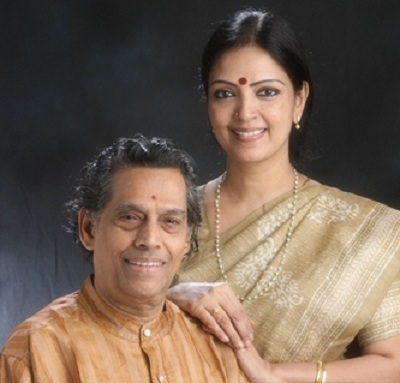
Narasimhachari and Vasanthalakshmi are well-known and highly respected performers, teachers and choreographers of the Bharathanatyam and Kuchipudi styles of Indian classical dance.
Together this ‘Made for each other couple’ (as the press often refers to them) felt greater strength and impetus for progress. They have trained in Kuchipudi from Sri. Pasumarthi Venugopala Krishna Sharma, Sri. Mahankali Satyanarayana and Sri C.R. Acharya. The Narasimhacharis then learnt Odissi from Sri. Ramani Ranjan Jena, Kathak from Sri Vishnu Vaichalkar, Mohini Attam from Smt Vasantha Aravind and Kathakali from Kavi Aravind.
In 1969, they started the Kalasamarpana Foundation, an academy for thepropagation and promotion of the fine arts. Here numerous worthy students are taught not only the nuances of the art but also to be worthy human beings.Together with their students, the Narasimhacharis have produced as many as thirty-two dance-dramas and thematic presentations. The Narasimhacharis have travelled the world as cultural ambassadors showcasing the richness and glory of India in each of their performances, lecture-demonstrations and workshops.
Exposure to such varied classical art forms has enriched their choreography.
Performing professionally together since 1969, they have enchantedaudiences both in India and abroad with their beautiful technique, sensitive expression, original choreography and sincere devotion to the art. Their presentations are visual wonders creating on stage unforgettable images of human life.
For this couple, dance is a penance-a beautiful tool to convey messages of historical, religious and social relevance with aestheticism.
M.V. Narasimhachari
Maranganti Venkata Narasimhachari was born in Rajahmundry a beautiful city on the banks of River Godavari.
His father Sri Maranganti Satyanarayanachari was an artiste par excellence and was his first teacher.
Little Simham, for that was how Narasimhachari was lovingly addressed, was only five when he gave his first performance with his elder brother Anand.
This happy scene changed with his father’s sudden demise. While Anand took on odd jobs to support the family, Narasimhachari with the help of his uncle Sri Ramachari, a renowned critic and journalist of the time, revived the Burra Katha, a ballad form of Andhra Pradesh.
Along with his younger sister Lakshmi and brother Krishna he formed a troupe called ‘Simham and Party’ and performed Burrakathas winning accolades from the likes of Babu Rajendra Prasad, Uday Shankar and Harindranath Chattopadhyaya.
The trio very soon became the most popular group in Andhra Pradesh, so much so that they had the honour of performing for the then President of India, Dr.Rajendra Prasad. They called themselves “Simham & Party!
As a student of the first batch at the Music College of Tirupathi, Narasimhachari had the privilege of learning from stalwarts such as Chittore Subramaniam Pillai, Prof. Sambamurthy, D. Pasupati, S.R. Janakiraman and V.L. Janakiram, Mridangam from Shanmuganandam Pillai and Bharatanatyam from Smt Kanchanamala.
A turning point in young Chari’s life was when Smt Rukmini Devi Arundale upon witnessing one of his performances invited him to join the internationally renowned Kalakshetra. So impressed was she that she even offered him a scholarship!
While at Kalakshetra between the years 1962-67, Narasimhachari was trained in vocal music by the legendary M.D. Ramanathan and in Mridangam by Karaikudi Krishnamurthy. Smt. N.S.Jayalakshmi instilled in him the unique Kalakshetra Bani or style of dancing while Smt. Pushpa Shankar introduced him to the fascinating world of nattuvangam.
Narasimhachari graduated from Kalakshetra with a first class diploma and also obtained the Sangita Siromani degree from the Madras University.
He is a singer par excellence and is a very popular concert musician. Narasimhachari is a multi-faceted artiste known for his technical virtuosity on the Mridangam .
He is an Msc. in Yoga and has done extensive research on the use of yoga in dance. He has equipped himself with courses in Naturopathy, Homeopathy, Pranic Healing, Meditation and advanced yoga training.
Narasimhachari is a reputed music composer, choreographer, singer, nattuvanar, mridangam player, concert musician, performing artiste of Bharatanatyam and Kuchipudi and a guru of an outstanding capacity. He was the president of ABHAI (Association of Bharatnatyam Artistes of India) which has more than 1000 members for nine years. He is the director of Kalasamarpana Foundation established in 1969 (merged as the classical wing of Rasoham since 2007).
Vasanthalakshmi
Vasanthalakshmi, who began her career in dance at a very young age, joined Narasimhachari as his wife and partner in the year 1969. When Chari wedded Vasantha Lakshmi, Guru M.D. Ramanathan rightly foretold that this little lady will bring both Vasantham (spring) and Lakshmi(wealth) into his life.
Specializing in nattuvangam, Vasanthalakshmi also contributes the lyrics for their compositions and assists her husband in all their choreography. She has to her credit, several Sabdams, Padams, Varnams and Mangalams. She has also written the lyrics and composed the music for a unique Varnam set to the raga Shanmukhapriya and Khanda nadai Adi tala on Lord Subrahmanya. This challenging piece is being greatly appreciated by senior artistes and has found a place in the repertoire of several young dancers.
She is a veena player too. Vasanthalakshmi trained on the Veena under Smt. Kamala Aswathama and has enthralled audiences with her sweet command of the instrument.
Vasanthalakshmi is a guru of great caliber and is known for her creative brilliance and beauty that comes from uncommon humility!
She is not only a professional dancer and guru par excellence in both Bharathanatyam and Kuchipudi, but a gifted linguist, lyricist and an unmatched nattuvanar. Her perfect diction of complex rhythmic syllables are a treat to the learned ear.
Vasanthalakshmi’s expertise with the “Simhanandana Tala Chitra Nrithyam” in which the dancer draws the image of a lion with her feet has won her critical acclaim.
A glance at the list of dance dramas they have produced reveals the wide variety of themes and sources ranging from the mythological (Sivaleela and Kambaramayanam), the literary (Meghasandesa and Kalingathu-p-parani), the biographical (Annamacharya and Yashodhara), the scholarly (Natya Veda) to the contemporary (Voice of Ganga and Bharathi kanda Bharatham). Applying creativity and imagination they have shown that even non-traditional subject matter is suitable for entertaining, meaningful exposition through the medium of classical dance.


